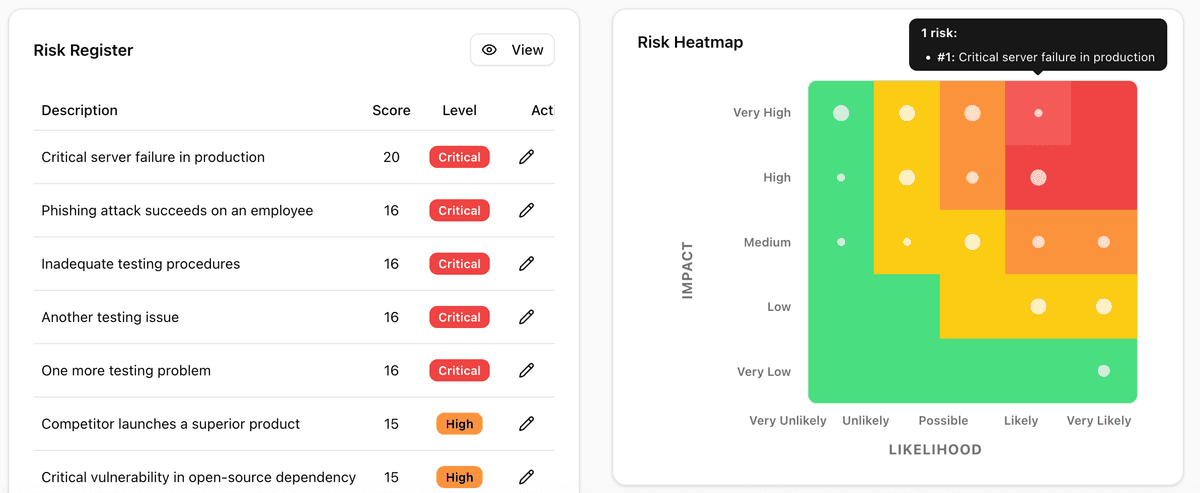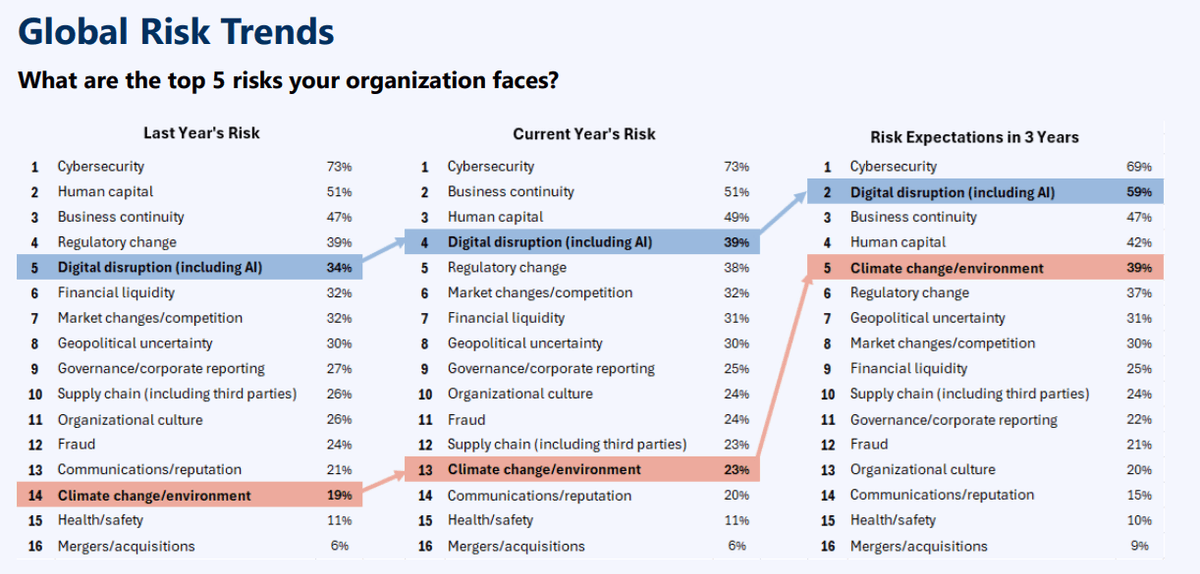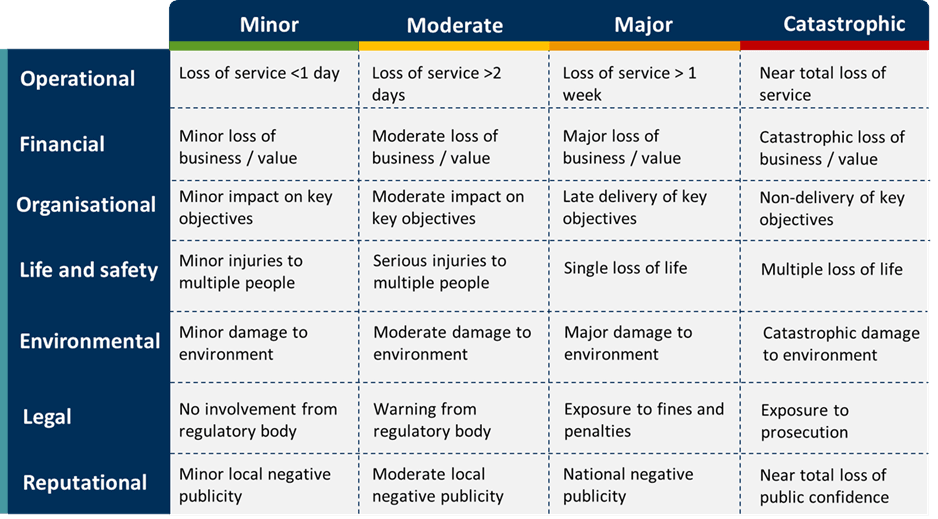You've got important things that you're trying to achieve. It could be executing company strategy, delivering a key project, promoting safety, keeping operations running smoothly, or ensuring compliance with regulations and legal commitments. Unfortunately, there's always going to be uncertain events that may pop up and impact your ability to meet your goals.
Fortunately, a structured and proactive approach to risk management can help you to prepare for this - so you can meet your goals faster and more consistently. And a cornerstone of effective risk management is the risk matrix.
This guide will explain what a risk matrix is, how to build one in 5 easy steps, and how to use one to help you meet your goals.
Want to try it yourself? Use our interactive risk matrix tool to create, score, and visualize risks in real-time as you read through this guide.
What is a Risk Matrix?
A risk matrix is a structured visual tool used to assess and prioritize risks based on two key dimensions: likelihood (how probable a risk is) and impact (how severe the consequences would be if it occurred). Sometimes called a risk assessment matrix or risk scoring grid, it helps organizations categorize risks as low, medium, or high, so they can make informed decisions about where to focus their time and resources. You can try building your own risk matrix using our interactive risk matrix tool.
Watch: Evaluating Risk - the Risk Matrix and the Heat Map
This video demonstrates how risks are plotted on a matrix and visualized as a heat map
Risks get plotted into quadrants, based on their ratings of likelihood and impact. By adding colors to each quadrant, a risk matrix becomes a heat map. In the example shown in the short video above, there are several risks shown, but the viewer's eye is intuitively drawn to the risks in the upper red quadrants - risks that have both a higher chance of happening and a greater expected impact.
Why is a Risk Matrix Important in 2025?
In 2025, the risk matrix has become more important than ever. Organizations are facing a volatile global environment. Economic uncertainty, tightening regulations, AI-related risks, climate disruption, and geopolitical instability are now core concerns for executives and boards. Risk matrices help cut through this complexity by providing a clear, structured way to evaluate threats and align responses with business priorities.
They're also a critical part of regulatory compliance frameworks and they support enterprise risk management (ERM) practices by identifying and prioritizing risks that can be later linked to strategic objectives, controls, policies, and action plans. In an era of heightened uncertainty, accountability and ESG expectations, the ability to clearly show how risks are identified, scored, and managed is not just best practice - it's essential.
Whether you're a small nonprofit or a global enterprise, a well-built risk matrix helps you proactively manage uncertainty, reduce surprises, and drive better outcomes.
How to Build a Risk Matrix (Step by Step)
Step 1 - Identify Your Risk Landscape
The first thing to do is to identify the risks that you should consider for your organization or activity. There are multiple ways to do this, depending on the activity that your risk assessment relates to. For example, you could consult risk libraries, old assessments, and/or compliance frameworks that may suggest risks to include. These have the benefit of giving you examples to start with, along with some comfort that you're not missing anything obvious.
Broad risk categories to consider include:
- Strategic Risks – risks related to strategic decisions and execution
- Operational Risks – risks from breakdowns in internal processes and procedures
- Financial Risks – risks related to financial losses, fraud, budget overruns
- External Risks – risks from sources that we don't directly control
- Emerging Risks - new and unforeseen risks that aren't on our radar, but should be
Most importantly, however, is to tap into the knowledge and experience within your organization. This will require you to speak to a wide range of individuals and roles, depending on the scope of your assessment exercise. In our experience, the best way to do this is to consider the outcomes you are trying to achieve and then hold workshop sessions with the subject matter experts who understand the objectives and your operations best. By examining the assumptions behind goals and timelines and the external factors that might impact plans, you will be able to identify risks to your objectives(affecting your achievement of them) and risks from your objectives (risks resulting from the pursuit of certain outcomes).
Step 2 - Configure Your Risk Matrix
Set up your risk matrix with likelihood on the y-axis and impact on the x-axis. This is the most common layout, but don't get too hung up if you see a risk matrix with these values plotted on the opposite axes. Then you have to decide how many rating levels you will have for each attribute. The most common configuration is a 5-point scale on each dimension, resulting in a 5x5 matrix and 25 quadrants in the matrix. Less common are 3x3 and 4x4 matrices, which are discussed below.
One great best practice is to create instruction sheets for team members who will be rating risks. These instructions work best when they include examples that are tailored to your specific organization or context, as shown in the 4-level impact example below, taken from ProtectUK.
A similar table can be created for your levels of likelihood. Together, this approach helps to ensure consistency across different risk reviewers, while still giving assessors the ability to exercise their independent judgment.
| Likelihood Level | Rating | Description | Frequency Guidance |
|---|---|---|---|
| Very High | 5 | Almost certain to occur | More than once per year |
| High | 4 | Likely to occur | Once per year |
| Medium | 3 | May occur | Once every 2-3 years |
| Low | 2 | Unlikely to occur | Once every 5-10 years |
| Very Low | 1 | Rare or almost impossible | Less than once every 10 years |
Example risk likelihood guidance table
Finally, when setting up your risk matrix, you can apply coloring to each quadrant to represent the overall rating of risks that are plotted in those quadrants - turning your risk matrix into a heat map.
Step 3 - Rate and Plot Your Risks
Now you and/or your subject matter experts will assign a value of likelihood and impact for each of your risks, using the rating scales and instructions developed in the previous step. These ratings will allow you to plot your risks on your matrix, resulting in a populated heatmap, like the one below.

Example risk matrix from Essential ERM
Step 4 - Consider Your Risk Tolerance Thresholds
Once you've scored your risks, define your organization's risk tolerance thresholds—the boundaries that distinguish which risks are acceptable and which require action. This is where you draw the line between low, medium, and high risk based on your organization's risk appetite. For example, a financial institution may tolerate moderate operational risks but have zero tolerance for regulatory compliance failures. Clearly documenting these thresholds ensures consistent prioritization, helps avoid overreaction to low-level risks, and guides decision-making on mitigation efforts. These thresholds also support alignment with executive expectations and board-level reporting.
Step 5 - Review and validate with stakeholders
Before finalizing your risk matrix, it's essential to review and validate it with key stakeholders across the organization. Risk perception can vary widely between departments, so gathering feedback ensures the matrix reflects a shared understanding of priorities and aligns with real-world experience. This collaborative step helps surface overlooked risks, refine scoring judgments, and build organizational buy-in. It also reinforces accountability by confirming who owns each risk and what actions will follow. A validated matrix becomes a trusted decision-making tool - not just a compliance formality.
Risk Matrix Examples (3x3, 4x4, 5x5)
The examples shown earlier are all based on the more common 5 x 5 matrix, but what if you want to use a 3x3 or 4x4 matrix instead? We suggest you try out our free interactive risk matrix tool linked below. This tool allows you to select the gear icon to switch between 3x3, 4x4 and 5x5 designs. You can also test out creating and rating risks to populate a sample risk heat map and download your results to create your own examples.
🛠️ Try Our Interactive Risk Matrix Tool
Test different matrix configurations and create your own risk assessments
Open Interactive Tool3x3 vs 5x5 Risk Matrix: Which Is Better?
The choice between 3x3, 4x4, and 5x5 risk matrices depends on your organization's complexity and need for granularity. A 3x3 matrix is simple, easy to use, and ideal for smaller teams or high-level overviews. It's essentially a high-medium-low approach that is intuitive to most beginners. It may, however, oversimplify risk prioritization and will lead to most risks clustering in the middle. In practice, a 3x3 is useful only for a small number of risks and an initial rating activity. A 4x4 matrix offers a middle ground with better resolution without being overly complex, but it's less common and may lack industry-standard support.
A 5x5 matrix has become the industry standard, as it provides the most granularity, helping larger organizations distinguish between risks more precisely and allocate resources accordingly. Overall, more levels offer more precision, but also require clearer definitions as described in previous sessions.
How Often Should I Update a Risk Matrix?
Your risk matrix should be updated at least annually, but ideally it should be reviewed quarterly or whenever there are significant changes in your organization's risk landscape. In most jurisdictions, corporate directors have an obligation to oversee risk management as a component of their duty of care. As a result, it is common for the board of directors (or the board's audit committee) to expect risk updates as a component of quarterly board reporting. This typically includes an up-to-date risk matrix.
Trigger events might lead you to review risks more often include launching a new product, entering a new market, regulatory changes, major system upgrades, or emerging threats like cybersecurity incidents or AI risks. Regular updates ensure that the matrix reflects current realities and remains a reliable decision-making tool. Without periodic review, there's a risk of overlooking new threats or misjudging the relevance of older ones, potentially exposing the organization to avoidable harm.

Institute of Internal Auditors
Risk in Focus 2025 Board BriefingCommon Mistakes to Avoid When Using a Risk Matrix
Here are some of the most common mistakes that limit the effectiveness of risk assessments and the risk matrix:
Overclassifying risks
Labeling too many risks as high can dilute focus, create panic, and undermine prioritization.
Vague or inconsistent scoring criteria
Without clearly defined scales for likelihood and impact, teams may interpret scores differently, leading to unreliable results.
Failing to update the matrix regularly
Using outdated information can result in overlooking new threats or overestimating old ones. It also leads business people to lose faith in what they come to see as an ineffective process.
Ignoring inherent risk
Starting with a simple process that focuses on residual risk only can be effective, but ignoring inherent risk can lead to significant problems, including a false sense of security on heavily controlled risks, blind spots in scenario planning, difficulty prioritizing risk mitigation efforts, and more.
Lack of stakeholder involvement
Skipping input from key departments or subject matter experts can lead to blind spots in risk identification and a lack of buy-in for risk prioritization and risk mitigation plans.
No links to action plans or controls
A matrix alone doesn't reduce risk - it's merely the starting point to identify priorities. Failure to link risks to controls and action plans limits its practical value.
What is a Risk Control Matrix?
A Risk Control Matrix (RCM) is a structured tool that maps specific organizational risks to the controls designed to mitigate them, typically aligned with key business processes. It provides a clear view of how well risks are being managed by documenting the risk, associated control activities, control owners, and frequency of testing. Commonly used in financial reporting (e.g., SOX compliance), internal audits, and operational risk management, an RCM helps organizations ensure that controls are in place, effective, and aligned with both regulatory and strategic objectives. It also supports audit readiness and control testing by providing a single reference point for tracking risk-control relationships.
One best practice method to do scenario planning and map controls to risks in enterprise risk management is through the use of a risk bow tie diagram. Once again, we suggest you try out one of our free interactive tools linked below. This risk bowtie builder allows you quickly and intuitively map the scenarios and controls (existing and planned) related to a risk.
🎯 Try Our Risk Bow Tie Tool
Map scenarios and controls with our interactive bow tie diagram builder
Open Bow Tie BuilderReady to Lower Your Risk Scores?
If you're ready to take control of your risk exposure, the Essential GRC platform - including Essential ERM, Essential Strategy, Essential Compliance and more - gives you the tools to identify, assess, and reduce risks with clarity and confidence. Whether you're just getting started or looking to modernize your existing program, our intuitive, integrated platform makes it easy to build and maintain a risk matrix that supports better decisions and stronger outcomes. Book a no-obligation discussion with a risk advisor at Tracker Networks to explore how we can help streamline your risk and compliance efforts. Let's turn your risk data into a strategic advantage.
Ready to Implement Professional Risk Management?
See how Tracker Networks can help you build and manage effective risk assessment matrices with our comprehensive GRC platform.
